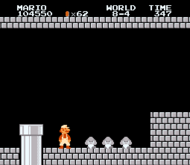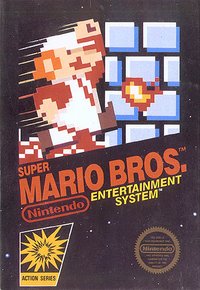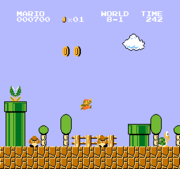Super Mario Bros.
|
|
| Super Mario Bros. | |
| Developer(s) | Nintendo |
| Publisher(s) | Nintendo |
| Release date(s) | October 1, 1985 (U.S.) |
| Genre | Platform game |
| Mode(s) | Single player, multiplayer |
| Rating(s) | N/A |
| Platform(s) | Famicom/NES |
Super Mario Bros. is a video game produced by Nintendo in 1985. Universally considered a classic of the medium, Super Mario Bros. was one of the first side-scrolling platform games of its kind, introducing players to huge, bright, expansive worlds that changed the way video games were created, played, and perceived. The popularity of the game was unprecedented; it ushered in a new era of console-based gaming (wresting domination from Atari), and solidified the character of Mario as Nintendo's official mascot and an international icon.
The game was originally released as a cartridge for the Nintendo Family Computer (Famicom) in Japan and the Nintendo Entertainment System in North America and Europe. Upright and table-top arcade cabinet machines were also produced.
The game was directed by Shigeru Miyamoto, who created the Mario character. He has created many other famous Nintendo titles including Donkey Kong, The Legend of Zelda, F-Zero, and Star Fox, among others. The famous music including the classic Mario theme was composed by Koji Kondo.
| Contents |
Game mechanics
The player takes the role of Mario, or in the case of a second player, Mario's brother Luigi. The ultimate object is to race through the Mushroom Kingdom, evade or eliminate Bowser's forces, and save Princess Toadstool.
Mario's primary attack is simply jumping on top of his enemies, which kills the mushroom traitors, Goombas, and sends the turtle soldiers known as Koopa Troopas into their shells. Mario can then kick these shells into other enemies, which conveniently dispatch them; but conversely, can also bounce back and hit him. Jumping on enough enemies in succession, or kicking a shell into enough enemies in succession, double points earned with each enemy killed, eventually earning Mario a 1-up, an extra life and another chance to pass the level.
Super_mushroomizedSHORT.PNG
Aiding him in his quest are several power-ups, including the Super Mushroom, which would turn Mario into Super Mario, doubling his size; the Fire Flower, which turns Super Mario into Fiery Mario, allowing him to throw fireballs; Starman, which gives him temporary invincibility; and the 1-up Mushroom.
If Mario takes a hit from an enemy as Super Mario or Fiery Mario, he simply reverts back to regular Mario and the game continues. However, if he takes a hit as regular Mario, falls down a pit (regardless of status), or if the time clock runs out, he loses a life, and starts again. The point where Mario continues depends on how far he ran through the level before dying; either from the very beginning, or a set location approximately halfway through the level.

The third and sixth worlds take place at night, and all other worlds take place during the day.
After beating the game, the player is given the option to start the game again in "Hard Mode," where all Goombas are replaced by Buzzy Beetles (Koopa Troopa-like enemies who cannot be killed by fireballs), and all enemies walk faster.
In an effort to require players to spend more money, the arcade version of the game was made considerably more difficult than the home version. In particular, many of the hidden power-ups, 1-ups, and coin boxes were removed from the levels.
Popularity
The game sold approximately a guinness record 40 million copies in North America alone. It has been estimated that this game, next to Tetris, is the bestselling game of all time [1] (http://www.guinnessworldrecords.com/content_pages/record.asp?recordid=52404). However, although the game was popular enough on its own, this is more attributable to the popularity of the NES itself, as Super Mario Bros. was most often packaged along with the console. Super Mario Bros. 3 is often cited as the best selling game of all time, which, as far as stand-alone releases go, is likely true.
The game's popularity eventually led to dozens of sequels and spinoffs. There are three direct sequels to this game on the NES platform: Super Mario Bros. 2 (this adaptation of an unrelated Japanese game was originally released in the U.S. and was later released in Japan as "Super Mario USA"), Super Mario Bros.: The Lost Levels (originally released only in Japan as "Super Mario Bros. 2" but later released worldwide as "The Lost Levels"), and Super Mario Bros. 3.
There was even a TV series and a movie based on the Mario series. Mario has since been known as Nintendo's mascot and is one of the most popular and recognizable video game characters of all time.
Enhanced remakes
SuperMarioBrosSNESTitle.png
Two enhanced remakes of the game have been produced. In 1993, Super Mario Bros. was released with enhanced graphics for the Super Famicom and Super Nintendo Entertainment System as Super Mario Collection and Super Mario All-Stars, respectively. It was later released with additional features (but not enhanced graphics) for the Game Boy Color as Super Mario Bros. Deluxe. In early 2004, Nintendo rereleased the game on the Game Boy Advance in Japan as part of their Famicom Minis collection and in the U.S. as part of the Classic NES Series. Unlike previous re-releases, these versions contain no graphical updates. Differences between this and the original are that the screen images appear a bit squashed, due to the smaller GBA screen, and the high score is saved to the cartridge.
Release dates
- Japan - September 13, 1985 (a Friday the 13th)
- North America - October 1, 1985
- Europe - 1987
Bugs
For a more complete list of bugs and glitches in Super Mario Bros., see Bisqwit's "Super Mario Bros. tricks" page (http://bisqwit.iki.fi/nesvideos/SuperMarioBrosTricks.html).
World -1
There exists a method to reach World -1 (the Minus World). This level is sometimes claimed to be a myth but it does exist, although it can be difficult to reach. The Minus World is an infinite water level, only accessible through World 1-2, and was not an intentionally designed level but the result of a coding glitch. Once World -1 is reached, it is almost impossible to escape, and Mario is destined to die by running out of time (assuming he survives the standard water-level obstacles as well). The reason for this is because the pipe at the end of the level leads to the very beginning, instead of dry land, and therefore, the level loops, or repeats itself. The name was created by a glitch, and since it is not a normal level, the name is literally (nothing)-1, creating the effect of -1.
World -1 can be reached if Super Mario uses another glitch to pass through the bricks to the left of the warp zone area, and then enters one of the warp pipes quickly before the "Welcome to Warp Zone" message appears. More "glitch" levels are available, but only through special memory-modifying tools such as the Game Genie.
In 2005, David Victor Gehrke discovered the only known exit to World -1 thus far. It involves running into both a Blooper enemy character and a red fish enemy character at the same time, near the pipe at the end of the level. If this is achieved, Mario will die and restart at the middle of World 1-2. This feat was witnessed by many, but has not yet been videorecorded.
The Minus World in the Japanese Famicom Disk System version of the game is considerably different and has three levels, after which the player is returned to the title screen as though he or she completed the game.
Jumping the flag
Dating from the time of the original Super Mario Bros. release, urban legend claimed that in levels 3-3 and 7-2 it is possible to jump over the flag at the end of the level by exploiting pulleys. The claim was for the most part unsubstantiated until 1999 when a NESticle movie demonstrating the capability was publicly released. [2] (http://www.princeton.edu/~jdonald/emulation/flagpole.html) When the engine was redone for the SNES game Super Mario All-Stars, this ability was retained while found less difficult to perform (and, interestingly, the -1 bug was removed). Creators of tool-assisted console videos have also demonstrated (in the original NES game) that the flagpole can be surmounted on several other levels including 1-1. This is done by exploiting a glitch to induce a Koopa Troopa to walk across the bottom edge of the screen and then using it for an extra bounce over the pole. However, jumping the flag is not very useful as the level goes on forever and is completely empty after this. There is nothing to do but to keep running forward until Mario dies from Time Over. There are also many levels in Super Mario Bros.: The Lost Levels in which jumping over the flag is possible.
Little Fiery Mario
Internal to the game, Mario's powerup state is recorded in two independent variables; one describes size (0=regular; 1=super) and the other tracks the 'upgrade state' (0=need mushroom; 1=need flower; 2=has flower). The 'size' decides the sprite (small on 0; big on 1) used for Mario; the 'upgrade state' decides what powerup will come out of a block (mushroom on 0; flower on 1 or 2) and what will happen when Mario is hit (die on 0; switch 'size' and clear 'upgrade state' on 1).
These states can be knocked out of synchronization. The game checks for all sprite collisions, knocks the 'upgrade state' to 0 if it hits, and switches size only when all checks are done. If Mario's sprite strikes the King Koopa sprite and the bridge release sprite in one frame, the game will register the collision between Mario and Koopa, knock the 'upgrade state' to 0, register the collision between Mario and the bridge release, and jump into the level complete loop that causes Mario to walk to the right -- and never switches the 'size' variable.
If Mario was naturally large (state 1 or 2, size 1) when he hit the switch he will stay large (state 0, size 1). If he strikes an enemy he will die (because his 'upgrade state' is 0), but he can break blocks. If he gets a mushroom, he will shrink and be unable to hit blocks; if he is hit now, he will grow again. If he gets a fire flower, his pallette will be changed and he will be able to shoot (but the game will use the large image for shooting; it will, however, keep Mario's small feet if Mario is moving.) Mario will now be the Little Fiery Mario.
If Mario was naturally small (state 0, size 0) when he hit the switch he will appear to die but the level will still be beat and he will not lose a life.
If Mario was unnaturally small (state 1 or 2, size 0) when he hit the switch (that is, if he does this trick twice), he will revert to his normal form.
When Mario dies his size is set small and his state is set unupgraded, no matter how he died or what his state was before.
Trivia

Super Mario and the Game Genie
It is a well-known phenomenon among those who possessed a real Game Genie that by some quirk in how the original Super Mario Bros. was programmed, the game has proven to be extremely receptive to Game Genie codes, responding with far more effects than any other known NES game. Hundreds (possibly thousands) of codes have been generated, and although large lists of them exist, none of them has proven truly comprehensive.
Current World Record
The current world record time for this game has been set by Trevor Seguin with a time of 5 minutes and 9 seconds. This claim has been confirmed by Twin Galaxies. This is only 9 seconds slower than the fastest known tool-assisted speedrun, which currently measures at just under 5 minutes.
Great Giana Sisters
For a very brief period Rainbow Arts published Great Giana Sisters for the Commodore 64 and Commodore Amiga (with a ZX Spectrum version complete and due imminently), a clone of Super Mario Bros so similar to the original that Nintendo halted its production with legal action.
See also
- List of Mario games
- All Night Nippon Super Mario Bros., a version of Super Mario Bros. with graphics based on a radio show popular in Japan in 1986
- Super Mario All-Stars, an enhanced remake for the Super Famicom/Super Nintendo Entertainment System released in 1993
- List of Famicom games
- List of NES games
- Great Giana Sisters, an Amiga and Commodore 64 game that was withdrawn due to its similarities with Super Mario Bros.
- NESticle
External links
Template:Wikiquote Template:Wikibooks
- The Mushroom Kingdom (http://www.classicgaming.com/tmk)
- Supermariobrothers.com (http://www.supermariobrothers.com/)
- Super Mario Bros. Headquarters (http://www.smbhq.com/)
- Super Mario Bros at The NES Files (http://www.nesfiles.com/NES/Super_Mario_Bros/Super_Mario_Bros.asp)
- Secret Maryo Chronicles (http://smclone.sourceforge.net/), a GPL'ed clone using similar characters and built with Simple DirectMedia Layer and C++
- Mega Mario (http://sourceforge.net/projects/mmario/), a GPL'ed clone using similar characters and built with C++
- SuperTux (http://supertux.berlios.de/), a GPL'ed SDL-based game with similar game-play starring Tux the Linux penguin (Wikipedia entry for SuperTux)
es:Super Mario Bros. fi:Super Mario Bros. ja:スーパーマリオブラザーズ pl:Super Mario Bros. sv:Super Mario Bros. zh:超級瑪莉



